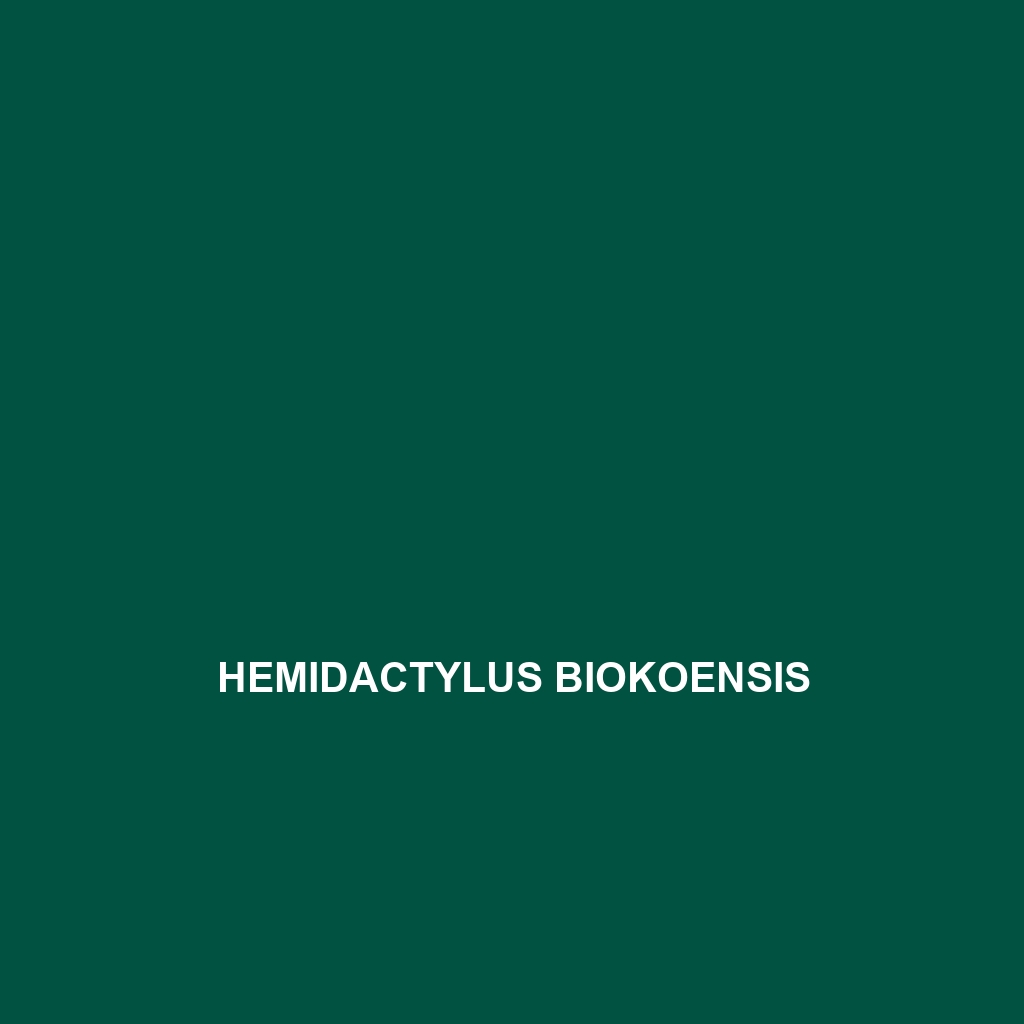Common Name
Hemidactylus biokoensis
Scientific Name
Hemidactylus biokoensis
Habitat
Hemidactylus biokoensis, commonly known as the Bioko Island gecko, is primarily found on Bioko Island, which is part of Equatorial Guinea. This species thrives in diverse habitats, predominantly within rainforests and temperate forests. The climatic conditions on Bioko Island, characterized by high humidity, warm temperatures, and abundant rainfall, provide a suitable environment for the gecko. With the presence of both coastal and inland marine habitats, these geckos often inhabit areas near rocky crevices and tree trunks, showcasing their adaptability to various ecological settings. The lush biodiversity of Bioko Island further supports the habitat needs of this fascinating species.
Physical Characteristics
Hemidactylus biokoensis is a medium-sized gecko, typically measuring between 8 to 10 centimeters in length. It displays a slender body structure with long limbs and a flattened head, which aids in navigating its arboreal environment. Its coloration is predominantly brown to grey, adorned with intricate markings that provide excellent camouflage against tree bark and foliage. One of the distinguishing features of this species is its large, adhesive toe pads, enabling it to climb smoothly on vertical surfaces. The presence of tubercular scales on its back further enhances its unique appearance, making it easily identifiable among other gecko species.
Behavior
The behavior of Hemidactylus biokoensis is primarily nocturnal, emerging at night to forage and engage in social interactions. During mating seasons, males exhibit territorial behaviors, often displaying physical postures to attract females while warding off rivals. Social interactions are typically characterized by vocalizations and physical displays. Nesting activities occur in sheltered environments, and the geckos demonstrate a distinct preference for specific habitats to establish their territories. Their nocturnal nature enables them to escape daytime predators, making them effective at avoiding danger while foraging for food.
Diet
Hemidactylus biokoensis is primarily an insectivore, feeding on a variety of arthropods, including crickets, moths, and beetles. Their diet can vary with seasonal availability, and they are known to adapt their feeding habits accordingly. The gecko employs its agile hunting skills and keen eyesight to catch prey during the night. This adaptability in diet allows Hemidactylus biokoensis to thrive in different environmental conditions, ensuring they meet their nutritional needs efficiently.
Reproduction
The reproductive cycle of Hemidactylus biokoensis is marked by a peak breeding season that aligns with the rainy months, ensuring optimal conditions for hatchling survival. Mating occurs through a courtship display, where males showcase their physical prowess. After mating, females typically lay two eggs per clutch within hidden nests in tree hollows or under leaf litter. The incubation period lasts approximately 6 to 8 weeks, depending on environmental factors. Once the eggs hatch, the young geckos exhibit minimal parental care and are immediately self-sufficient, highlighting the species’ strategy for survival.
Conservation Status
As of the latest assessments, Hemidactylus biokoensis is categorized as vulnerable due to habitat loss driven by deforestation and urbanization on Bioko Island. Conservation efforts are underway, with initiatives aimed at preserving the gecko’s habitat and raising awareness about the importance of biodiversity on the island. It is critical for local and international conservation organizations to monitor the populations to mitigate the threats they face from human activities and climate change.
Interesting Facts
One intriguing aspect of Hemidactylus biokoensis is its remarkable adaptability to diverse habitats. This species has developed a complex set of behaviors that allow it to thrive in both natural and disturbed environments. Additionally, their ability to change color slightly depending on environmental conditions adds to their unique charm. Interestingly, they are also known for their vocal communication, using different calls to convey various messages, which is a relatively unusual trait among geckos.
Role in Ecosystem
Hemidactylus biokoensis plays a significant role in its ecosystem as both a predator and prey. By controlling the population of insects, it helps maintain the ecological balance within its habitat. Additionally, as a food source for larger predators, such as birds and snakes, these geckos contribute to the nutrient transfer within their ecosystem. Their interactions with other species, both directly and indirectly, support the health and function of the forest and coastal ecosystems in which they reside.
